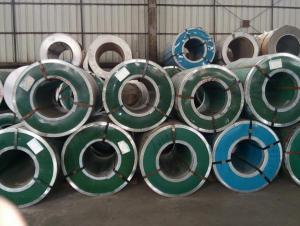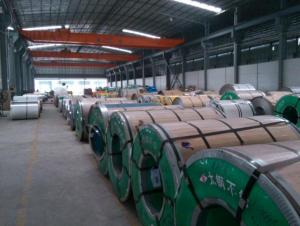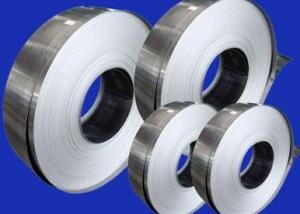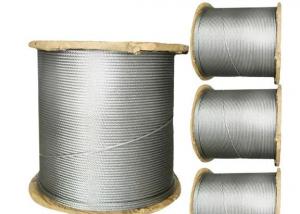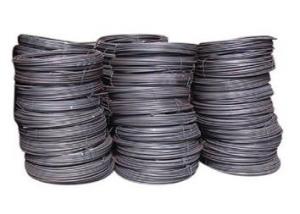Best Quality for Stainless Steel Coil
- Loading Port:
- China Main Port
- Payment Terms:
- TT or LC
- Min Order Qty:
- 1 Ton m.t.
- Supply Capability:
- 30000ton per month m.t./month
OKorder Service Pledge
OKorder Financial Service
You Might Also Like
AISI 304 Stainless Steel Coil
1. Chemical Composition
C | Si | Mn | P | S | Ni | Cr |
max0.08 | max1.00 | max2.00 | max0.045 | max0.03 | 8.00-10.50 | 18.00-20.00 |
2. Mechanical Properties
Yield Strength | Tensile | Elongation | Hardness (HV) | Hardness (HRB) |
≥ 205 | ≥ 520 | ≥ 40 | ≤ 200 | ≤ 90 |
3. Standard: AISI, ASTM, GB, EN, DIN, JIS
4. Surface: 2B, NO.1, BA, NO.4, Hairline, SB, Mirror finish, Anti-skid, Cherkered etc.
5. Size:
Thickness: 0.3-3mm (cold rolled), 3-40mm (hot rolled)
Width: 1000mm or 1219mm or 1240mm for cold rolled, 1500mm for hot rolled.
Length: As customers' request.
6. MOQ: 1 Ton
7. Payment terms: T/T or L/C
8. Packing: Seaworthy package with wooden or Iron pallets with the paper and the steel strip, or as customers' request.
9. Delivery time: Usually about 7 days after we confirming the order, or according to your quantity.
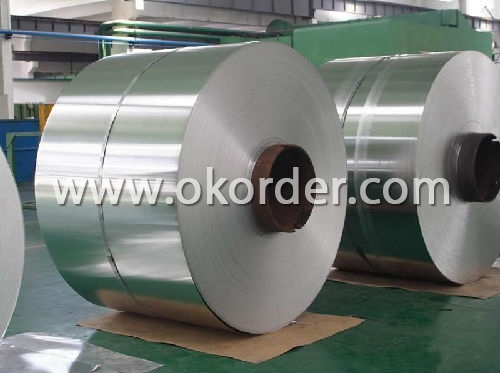

- Q:Is stainless steel wire resistant to UV rays?
- Generally, stainless steel wire is resistant to UV rays. It is well known for its ability to resist corrosion, including the effects of UV rays. Although extended exposure to direct sunlight may cause some discoloration or minor surface changes, stainless steel wire is unlikely to degrade or lose its structural integrity due to UV radiation. This makes it an appropriate choice for outdoor applications like fencing, outdoor furniture, and architectural features that will be exposed to sunlight for long periods. However, it is important to consider that the UV resistance of stainless steel can be influenced by the specific grade and finish. Therefore, it is always recommended to consult the manufacturer's recommendations for optimal performance in outdoor environments.
- Q:What are the different types of stainless steel wire for different levels of malleability?
- There are various types of stainless steel wire available, each with different levels of malleability. The malleability of stainless steel wire is determined by its composition and processing method. 1. Austenitic Stainless Steel Wire: This type of stainless steel wire is highly malleable and can be easily formed, bent, and shaped without breaking. It is non-magnetic, corrosion-resistant, and commonly used in applications requiring good formability, such as wire mesh, springs, and kitchen utensils. 2. Martensitic Stainless Steel Wire: Martensitic stainless steel wire offers moderate malleability. It can be hardened through heat treatment, which makes it suitable for applications requiring high strength and hardness. It is commonly used in cutlery, medical instruments, and springs. 3. Ferritic Stainless Steel Wire: Ferritic stainless steel wire has poor malleability compared to austenitic and martensitic types. It is magnetic and exhibits good corrosion resistance. Due to its limited formability, it is often used in applications that require higher resistance to corrosion, such as automotive exhaust systems and decorative trims. 4. Duplex Stainless Steel Wire: Duplex stainless steel wire combines the qualities of both austenitic and ferritic stainless steel. It offers good malleability, excellent corrosion resistance, and high strength. It is commonly used in marine environments, chemical processing equipment, and oil and gas industries. It is important to consider the specific requirements of your application, such as formability, strength, and corrosion resistance, when selecting the type of stainless steel wire. Consulting with a supplier or an expert in the field can help ensure you choose the right type of stainless steel wire for your specific needs.
- Q:Is stainless steel wire suitable for wire EDM cutting?
- Yes, stainless steel wire is suitable for wire EDM (Electrical Discharge Machining) cutting. Wire EDM is a precision machining process that uses electrically charged wire to cut through various materials, including stainless steel. Stainless steel wire is commonly used in wire EDM cutting due to its high strength, durability, and resistance to corrosion. It can effectively cut through thick stainless steel materials with high precision and accuracy. Additionally, stainless steel wire offers excellent thermal conductivity, which helps to control the temperature during the EDM process and prevent distortion or warping of the workpiece. Overall, stainless steel wire is a suitable choice for wire EDM cutting applications involving stainless steel materials.
- Q:Can stainless steel wire be used for wire rope applications?
- Yes, stainless steel wire can be used for wire rope applications. Stainless steel wire ropes are known for their high strength and corrosion resistance, making them suitable for a wide range of applications. They are commonly used in industries such as construction, marine, and transportation, where durability and resistance to environmental factors are essential. Stainless steel wire ropes are also popular in outdoor activities like rock climbing and zip-lining, where safety is paramount. Additionally, stainless steel wire ropes can withstand high temperatures and are resistant to chemicals, making them a reliable choice for various specialized applications.
- Q:Is stainless steel wire suitable for high-temperature applications?
- Indeed, stainless steel wire proves to be a fitting option for high-temperature applications due to its exceptional heat resistance characteristics. Withstanding elevated temperatures without compromising its strength or structural integrity, stainless steel wire finds extensive utilization in industries like automotive, aerospace, and manufacturing, where exposure to extreme heat and thermal cycles is prevalent. Moreover, its resilience against oxidation and corrosion further guarantees its durability and reliability in high-temperature environments. Additionally, stainless steel wire retains its mechanical properties even at elevated temperatures, rendering it an optimal selection for diverse industrial processes necessitating heat resistance.
- Q:Several ways of drawing stainless steel wire drawing.
- According to decorate need drawing straight lines, made several chaotic patterns, thread, corrugated and twistcore. Straight line drawing refers to the surface of aluminum processing with a mechanical friction method of straight lines. It has the dual role of brushed aluminum plate surface scratches and decorative aluminum surface. A continuous wire drawing straight lines and intermittent thread two. Continuous threads available 100 clean cloth or stainless steel brush through continuous horizontal lines on the surface of aluminum friction (such as in the device under the condition of * manual skill grinding or planer clamped in the aluminum wire brush grinding brush).
- Q:Can stainless steel wire be used for electrical purposes?
- Yes, stainless steel wire can be used for electrical purposes. It is often used in applications where corrosion resistance is important, such as in marine and outdoor environments. However, it is not as conductive as copper wire, so it may not be suitable for high-conductivity applications.
- Q:Does stainless steel wire conduct electricity?
- Indeed, electricity can be conducted by stainless steel wire. Comprised predominantly of iron, carbon, and chromium, stainless steel is an alloy enriched with various other elements. These constituents grant stainless steel its distinct characteristics, including its capacity to conduct electricity. Nevertheless, it is imperative to acknowledge that although stainless steel wire can conduct electricity, its efficacy may not match that of metals such as copper or aluminum.
- Q:Can stainless steel wire be used for wire rope lanyards?
- Yes, stainless steel wire can be used for wire rope lanyards. Stainless steel is known for its strength, durability, and corrosion resistance, making it a suitable material for various applications, including wire rope lanyards. Stainless steel wire ropes are often used in industries such as construction, marine, and mining, where high tensile strength and resistance to environmental factors are required. The stainless steel wire provides excellent resistance to rust, making it suitable for outdoor and marine environments where exposure to moisture and saltwater is common. Additionally, stainless steel wire rope lanyards can withstand heavy loads and provide reliable support and safety in various situations.
- Q:What are the different types of stainless steel wire springs used in the construction industry?
- The construction industry offers a range of stainless steel wire springs with different purposes. Here are some commonly utilized types: 1. Compression Springs: These springs resist compressive forces and are ideal for absorbing or storing energy in doors, windows, and mechanical equipment. 2. Torsion Springs: Torsion springs apply rotational force and are commonly found in garage doors, hinges, and suspension systems. They store and release energy through twisting or rotation. 3. Extension Springs: Used to absorb and store energy when stretched or extended, extension springs are commonly used in trampolines, garage doors, and industrial equipment. 4. Wire Forms: Wire forms are custom-made springs that serve specific functions such as hooks, clips, or brackets. They are widely utilized in construction for fastening and supporting components. 5. Flat Springs: Also known as clock springs, flat springs are thin stainless steel strips wound in a spiral shape. They provide a constant force or torque and are commonly used in clocks, measuring devices, and automotive components. Each stainless steel wire spring type possesses distinct properties and applications. Choosing the right spring depends on factors like the specific function, load requirements, space limitations, and environmental conditions. Consulting a professional or engineer can aid in selecting the most suitable stainless steel wire spring for a construction project.
1. Manufacturer Overview |
|
|---|---|
| Location | Zhejiang,China |
| Year Established | 2000 |
| Annual Output Value | Above US$8.3 Million |
| Main Markets | Europe, America |
| Company Certifications | ISO9001:2000 |
2. Manufacturer Certificates |
|
|---|---|
| a) Certification Name | |
| Range | |
| Reference | |
| Validity Period | |
3. Manufacturer Capability |
|
|---|---|
| a)Trade Capacity | |
| Nearest Port | Shanghai |
| Export Percentage | 30% |
| No.of Employees in Trade Department | 30 People |
| Language Spoken: | English;Chinese |
| b)Factory Information | |
| Factory Size: | Above 80,000 square meters |
| No. of Production Lines | Above 7 |
| Contract Manufacturing | OEM Service Offered;Design Service Offered |
| Product Price Range | Average |
Send your message to us
Best Quality for Stainless Steel Coil
- Loading Port:
- China Main Port
- Payment Terms:
- TT or LC
- Min Order Qty:
- 1 Ton m.t.
- Supply Capability:
- 30000ton per month m.t./month
OKorder Service Pledge
OKorder Financial Service
Similar products
New products
Hot products
Hot Searches
Related keywords

